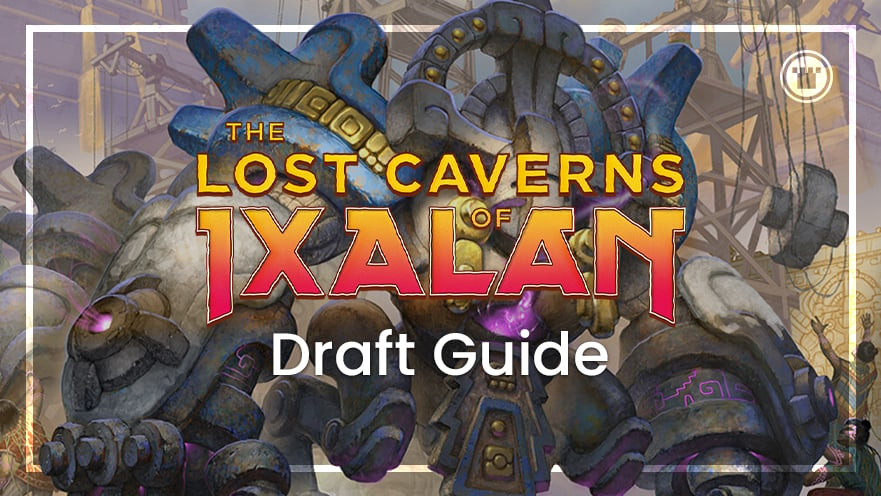Alright drafters, get ready to explore a new format, descend through an extensive analysis of available archetypes and then craft together bits of ancient wisdom to form your own full-fledged understanding of the set. It’s time for the Card Kingdom Draft Guide to Lost Caverns of Ixalan!
THE SHAPE OF THE FORMAT
After jamming Lost Caverns draft a lot since its release, I’ve confirmed my preview-season assessment: this is quite a weird and unique format to play. Be prepared to challenge your default assumptions of the Limited world when you journey here, just like an old-fashioned explorer.
This is a graveyard set, but it still doesn’t doesn’t place as much focus on recursion as you might expect. Instead, you are mostly incentivized to mill, discard or trade to enhance your cards already in play (or which will be played later).
Lost Caverns is a set where players never run out of things to do with their mana! Explore can significantly increase how many cards you “see” (i.e., have a chance to draw or use) in a given game. It also lets you cast those cards more consistently thanks to all the extra land drops the mechanic helps you make.
Throw in a trove of treasure generation plus the now-customary set of common land-cycling creatures, and you can basically guarantee having the right mana every game without even needing to aggressively draft fixing or nonbasic lands.
To ensure you can truly appreciate this mana-rich paradise, every Lost Caverns of Ixalan draft is brimming with desirable, flexible mana sinks. Craft, flashback, equip, cycling and repeatable activated abilities combine to all but eradicate empty turns, even if you do run out of spells in hand to cast.
The most prominent and influential example is the cycle of “discover caves,” acting as a powerful wildcard in almost every deck for when no better plays are available.
ANCIENT POWER UNLEASHED
So, what does Limited gameplay look like when resources are so freely available?
Usually it means closer, longer games with relatively even boardstates. Since players are rarely defenseless, you need to find ways to grow faster than they do. Then use your lead to pressure them into bad trades which eventually lead to victory.
Decks that aren’t designed to scale need to instead find ways to reliably push through damage and force a race after the opponent inevitably stabilizes with blockers.
As you might have noticed, Lost Caverns is heavily biased towards permanents. Every archetype, from tempo to control, is trying to build up a board state toward some particular goal. It feels a little bit like casual Commander: you start evaluating cards based on their flexibility and potential to scale in longer, synergy-driven games.
With so many mechanical and metagame incentives to maximize the number of permanents in each deck, plus the ease of splashing off-color bombs, only the most impactful one-time effects are making the cut. Not even removal spells are safe from re-evaluation — and in fact, the tendency toward large, stalled boardstates means it’s often not as crucial to destroy a single large creature so long as your overall position is good enough to come out ahead in any potential combat.
DECK ARCHETYPE BREAKDOWN
While Lost Caverns of Ixalan only features the bare minimum number of multi-colored cards, you will still usually end up playing two colors in your Draft deck — if not more! One color decks are still possible, but considering how easy three and four-color decks are to run, you need a very synergistic mono-color card pool to justify it.

The high level of natural synergy between different set mechanics means that the following two-color archetypes are more a starting point than strict options. And that said, almost any cards I mention as good in one archetype will still kick ass in other decks of that color, so don’t be afraid to mix and match once you’ve got a few drafts under your belt!
I’ve personally found this flexibility to be one of the greatest joys of Lost Caverns Limited so far.
Blue/White: Artifact Control
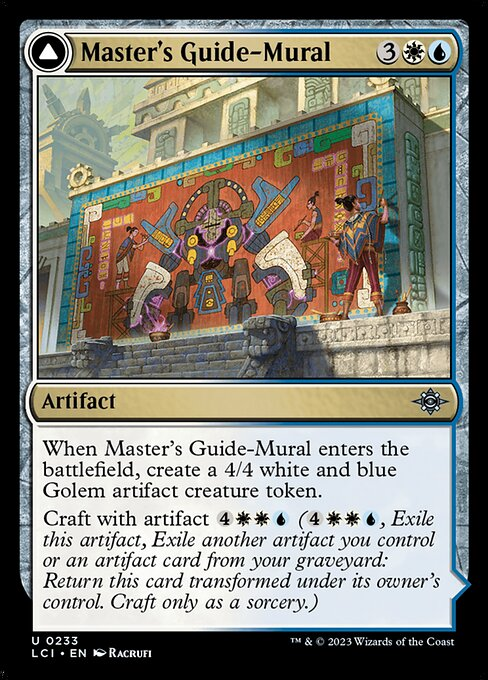

Showcasing the new “craft with” mechanic, blue/white decks look to play defensively and extend the game until they can reassemble the techno-magical marvels of the ancient Oltec people.
Fusing together inexpensive early-game utility cards into genuine threats gives this color pair a dominant power spike as soon as they reach the six or seven-mana mark — particularly if they can flip Master’s Guide-Mural, which is perhaps the strongest non-rare in the set!

The real goals to keep in mind when drafting blue/white are card selection and early tempo. You need to hit all your land drops without green’s easy access to ramp (not to mention finding the necessary artifacts to pay for craft and fuel a flipped Guide-Mural).
You also want to be as safe and healthy as possible as you reach that six-to-seven mana threshold, because taking your entire turn off to craft can give opponents a window to exploit. Solid blockers like Shipwreck Sentry and Frilled Cave-Wurm, plus white’s strong anti-attacker removal, will set you up for a prosperous, golem-filled endgame.
White/Black: Aristocrats Aggro

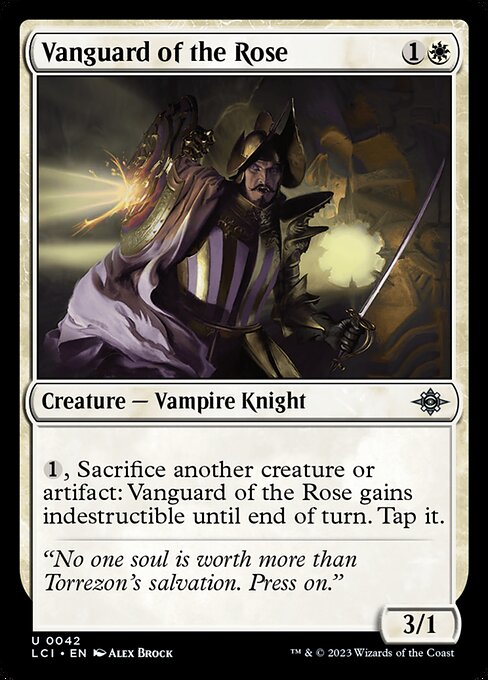
Made famous by the noble-blooded vampires of Innistrad, “aristocrats” has become Magic shorthand for a very specific aggro game plan. Your key threats are creatures like Vanguard of the Rose or Vito’s Inquisitor, which can become stronger for little or no mana cost by sacrificing other permanents.
Since every random fungus token and Mephitic Draught can now represent an extra life on your aristocrats, you are effectively making them all as valuable as your best creatures!
Knowing that game plan is important, because it gives white/black a completely different perspective when evaluating cards. Anything that produces multiple permanents from one efficient spell becomes a great value pick: Tinker’s Tote, Cartographer’s Companion, Careening Mine Cart.
You also have some of the best consistency at hitting descend each turn, so cards like Deep Goblin Skulltaker and Canonized in Blood are great value. Meanwhile, anything that can help a single attacker trade better against multiple blockers is also a potential lifesaver: Grasping Shadows, Might of the Ancestors, Fungal Fortitude, equipment, combat trick, and so on.
All that matters is keeping your aristocrats alive, well and on the offensive. Otherwise you’ll just be left with a bunch of 1/1s and no outs.
White/Red: Go-Wide Aggro


As I hinted in the shape of the format section, Lost Caverns has some very novel ideas about what “aggro decks” look like. Rather than its usual blend of 3/1s and combat tricks, the red/white deck here is all about 1/3s and surplus permanents.
Unlike the Aristocrats deck though, this pair isn’t sacrificing those spare gnomes and treasures — it’s trying to make the biggest collection possible in order to power various damage-enhancing abilities like Sunshot Militia or Goldfury Strider.
While there are some handy artifact synergies available from Dowsing Device and the like, these essential “tap two untapped things” cards don’t care what permanents you have — only that you have them. That makes it potentially very easy to activate them four or five times a turn after the midgame, which gives red/white one of the most reliable ways to finish opponents off without needing to dominate the combat step.
Not actually attacking with your small creatures also gives you the chance for sudden lethal bursts if you can land a team-wide buff like Malamet War Scribe or pay for Guardian of the Great Door. So make sure not to throw creatures away just for a point or two of early damage, or you’ll be sorry later when you’re one Adaptive Gemguard activation short of lethal!
Gree/White: Go-Tall Aggro

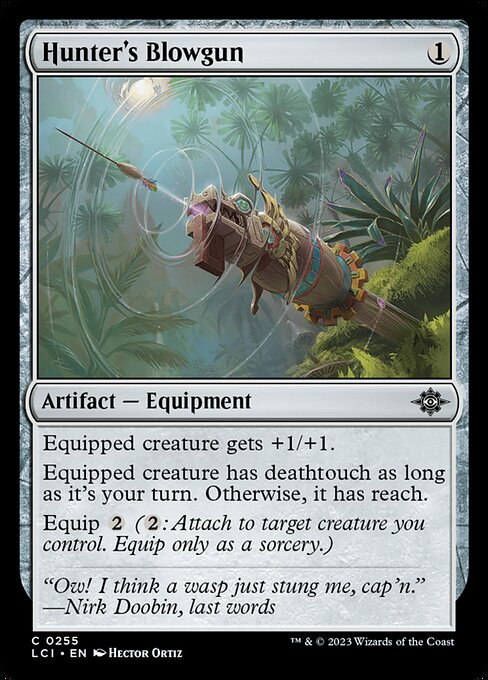
Broadly speaking, green/white plays a creature aggro game in the complete opposite way to red-white. Rather than being incentivized to generate as many creatures (and artifacts) as possible, this archetype wants to play strong, tough creatures and then make them even bigger with equipment, +1/+1 counters and combat tricks.
So long as you stay ahead in the race and can make your creatures big enough that blocking is unfavorable, you should be able to get wins with this very straightforward gameplan.
The two most important factors to my success with this color pair have been getting strong creatures as the “base” for your buff effects and using the most mana-efficient buffs possible. Particularly, if you’re relying on one-shot enhancements like Staggering Size, you REALLY want your creature to be bigger than blockers on its own so your opponent is pressured to commit their interaction before you use yours.
Cheap equipment like Hunter’s Blowgun is a more reliable way to complicate blocking and trigger Kutzil every turn, but that path loses the potential for surprise blowouts.
Of course, you can always skip around the blocker problem entirely by dropping your buffs on one of white’s flyers! Outside of a Poison Dart Frog, there are very few ways to slow down such an air attack once they’re 3/3 or bigger.
Blue/Black: Descend Control

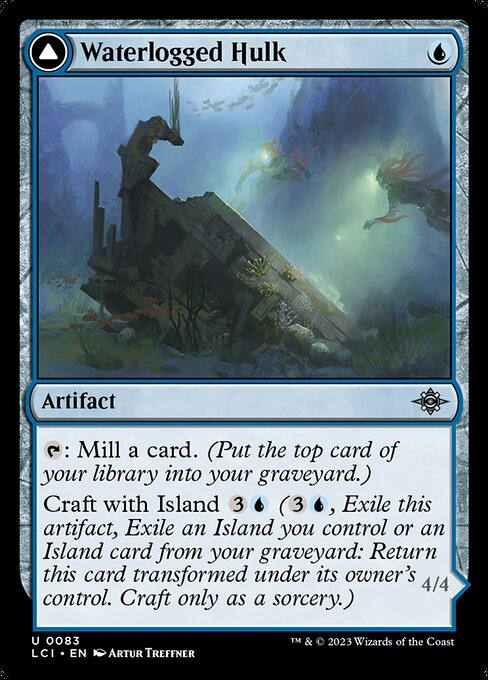
All the black archetypes in The Lost Caverns of Ixalan are graveyard decks built around the descend mechanic. But not every descend card cares about your graveyard in the same way!
Blue/black tends to run the spells that count the total number of permanents in your graveyard (a.k.a. threshold or undergrowth) instead of checking whether you have increased that total during the current turn. That just means your spells get stronger over time — perfect for a classic, controlling strategy.
Without the clear direction that blue/white gains from its artifact synergies, blue/black has the blessing/curse of choosing which subthemes to lean into every draft.
You can play a more up-tempo game with cheap flyers and explore to buff them while filling the yard. If you grab good artifacts, like Waterlogged Hulk and Visage of Dread, you can try and splash red or white for extra support in those colors. After all, Master’s Guide Mural remains S-tier as a source of inevitability. Just make sure you keep your total permanent count high and you can’t really go wrong!
This is also the color combination most rewarding of caves thanks to the combination of Cavernous Maw, Gargantuan Leech and Sinuous Benthisaur. Caves will also help you splash for off-color bombs, particularly if you can snag a Forgotten Monument and either Compass Gnome or Scampering Surveyor to tutor it up.
Blue/Red: Artifact Tempo
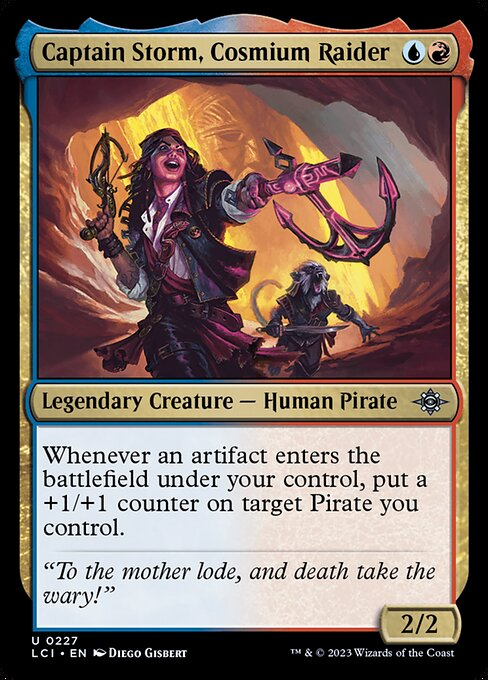

Blue/red is the archetype of Captain Lannery Storm and her brazen coalition mateys — an aggressive, artifact-loving bunch who are trying to get in under the clunkier green and black decks of the format.
Most of the pirates in the set are cheap creatures that care about artifacts, while many of the artifacts offer efficient ways to buff attackers or clear aside blockers. There are also a limited number of vehicles, which remain an excellent way for decks full of small expendable creatures to outplay larger blockers and removal spells.
Unfortunately, I’ve found this deck to be notably weaker than the others, both playing it myself and playing against it many times. It often feels like the entire deck is Grizzly Bears, and those bears get outclassed very quickly when you consider the relentless board expansion which defines Lost Caverns of Ixalan.
If I were going to draft this deck again, it would have to be with a bunch of the recurring treasure generators: Diamond Pick-Axe, Enterprising Scallywag and Careening Mine Cart.
Not only are they your best shot by far at getting real value out of the pirate synergies quickly, but they let you splash for cards you need to patch the holes in your game, or ramp into the kind of bombs that can actually give you a late game. There’s simply not enough power in this pair alone to pursue it over everything else in the format.
Blue/Green: Explore Midrange


If blue/red has been the hardest deck to make work from my time researching the format, blue/green is easily the most consistent. I would credit some of that to how amazing explore triggers are in Limited, but it’s also a testament to the sheer depth of quality in green’s card pool.
Huatli’s Final Strike and Over the Edge are some of the best answers in any color, and they can both be maindecked in multiples. Poison Dart Frog is simultaneously top-tier fixing, ramp and a consistent answer to two of the three main win conditions in the set: enormously buffed ground attackers and flyers.
Your life gain cards and overwhelming combat potential in the mid-to-late game helps you win the race against direct damage from Sunshot Militia decks.

These strengths are shared by all green decks, but blue is still probably the best secondary color. It gives greater access to explore, good card selection — and most importantly good flyers as a way to close games that stall on the ground.
But why limit yourself to just blue/green? Explore, frogs and the odd landcycler are all you need to splash a third, fourth, even fifth color. And then you can run Sunbird Standard as a cute payoff!
Black/Red: Descend Tempo

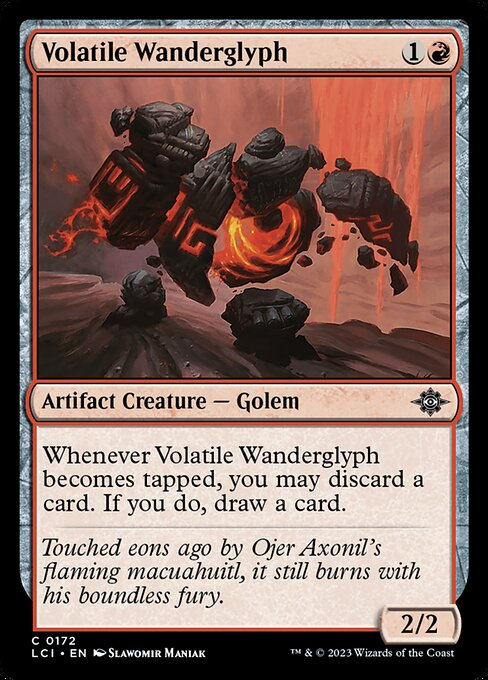
I have barely seen this archetype played at all, but I don’t think it’s from a total lack of potential. More likely there are just not many cards that specifically pull players into this combination compared to the more obvious synergies, like dinosaurs or aristocrats.
Zoyowa Lava-Tongue is going much later in packs than any other gold uncommon, and it seems much more likely that drafters with a strong start in either red or black try to steer into white or green for their second color than end up here.
On the upside, black does seem like a much better choice to power a red tempo strategy compared to blue. Black has efficient removal up and down the curve, even at instant speed should you snag Join the Dead or Bitter Triumph.
That strategy can make more efficient use of red’s treasure generation by feeding it to the vampire aristocrats. Black has the most descend payoffs, while red is extremely good at descending efficiently each turn thanks to cards like Sunfire Torch and Volatile Wanderglyph.
I also want to specifically highlight black’s historically great hand disruption, something which will single-handedly win some games for any black archetype. Between Visage of Dread, Deepcavern Bat and Skullcap Snail, black can very easily strip your starting hand of potential threats.
Getting into topdeck mode early against cards like Tithing Blade and Chupacabra Echo is extremely rough, and coming back from that spot against red/black’s menace creatures is rougher still.
Black/Green: Descend Midrange


For my money, these are the two strongest colors overall in Lost Caverns of Ixalan, and their combination doesn’t lack for synergy either. Green’s explore package is effective support for descend, while black adds strong card selection and board control that green is very excited for.
Green can brutally punish any stumbles resulting from black’s early disruption – not least with the signpost uncommon Akawalli, the Seething Tower, who is regularly a three-cost 7/7!
You can basically re-read everything I said under blue/green regarding card quality and mentally reapply it here. Mineshaft Spider is in a particularly nice spot on the curve and can really hold down the defenses while helping you switch on cards like Basking Capybara and Akawalli itself.
Ultimately, having the biggest creatures and strongest removal can’t really fail you. Especially in such a board-centric, removal-light format as this one.
Red/Green: DINOSAURS!

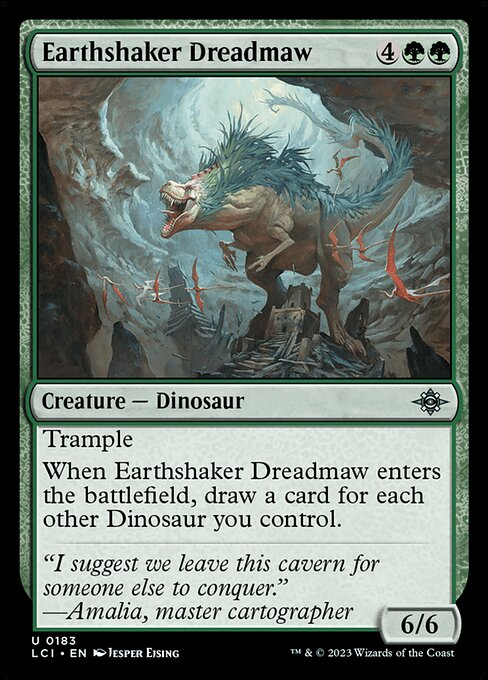
I’m sure this is probably the archetype people need the least help on — you realize you’re in red-green, you draft a bunch of dinosaurs because they’re all good cards in their own right, you maybe grab one of these two dinosaur payoffs when you see it. Then you curve out with huge creatures and go undefeated. Limited is just so easy sometimes…

Daydream or not, this deck is indeed a serious contender. Red’s underutilized combat tricks grant first strike and trample — which is perfect for huge attackers. It has good creatures for the deck’s early curve, including Belligerent Yearling and Burning Sun Cavalry or Dinotopian.
It also offers up Panicked Altisaur, a potent direct-damage threat that as a common, you can easily have in multiples. Green doesn’t need to change its plan much, but having a bunch of two and three-mana ramp spells does help you get to the good top-of-curve stuff much faster.
Shoutouts once again to the underrated Hunter’s Blowgun, whose deathtouch-granting efficiency really shines in a deck with the most access to trample across the formats!
CHIMIL SWEEP
The Lost Caverns of Ixalan might not be a perfect format, but what small nitpicks I do have can be set aside in applause of such bold experimentation. This set feels like a distinct re-imagining of Limited Magic, and one that low-key solves THE all-time famous gripe about Magic gameplay in mana screw!
I’m always going to be biased towards permanent-centric gameplay like this, but I think this style actually appeals to a big chunk of the Magic audience. After all, you get to play a lot more Magic per game!
That’s something I usually say in reference to Commander, which I don’t see as a coincidence. If the designers were trying to invoke the feeling of old-school casual Commander within this Limited environment, I think they’ve proved their point.
There’s still a lot more we have to learn about The Lost Caverns Draft as a community, but for now I can at least say with confidence that it’s balanced, unique, flavorful and fun. What more could you ask for from your Draft set?
BONUS PICKS: BEST PACK ONE COMMONS BY COLOR:
- White: Cosmium Blast, Oltec Cloud Guard, Petrify
- Blue: Waterwind Scout, Frilled Cave-Wurm, Song of Stupefaction
- Black: Join the Dead, Screaming Phantom, Deathcap Marionette
- Red: Sunshot Militia, Abrade, Panicked Altisaur
- Green: Huatli’s Final Strike, Poison Dart Frog, Armored Kincaller
- (also any landcycling dinosaur)

Tom’s fate was sealed in 7th grade when his friend lent him a pile of commons to play Magic. He quickly picked up Boros and Orzhov decks in Ravnica block and has remained a staunch white magician ever since. A fan of all Constructed formats, he enjoys studying the history of the tournament meta. He specializes in midrange decks, especially Death & Taxes and Martyr Proc. One day, he swears he will win an MCQ with Evershrike. Ask him how at @AWanderingBard, or watch him stream Magic at twitch.tv/TheWanderingBard.

